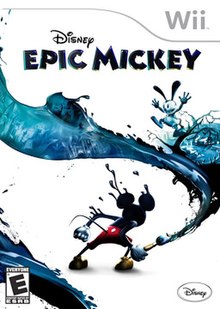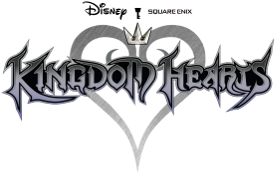Setting
The game is set in the Wasteland, a pen-and-paper stylized world, created in the game's narrative by the sorcerer Yen Sid, as a place for "forgotten things", namely disused or obscure Disney characters. [8] It is physically inspired by Disneyland, and appears as an intricate model in Yen Sid's workshop. However, Mickey Mouse's fiddling with Yen Sid's paintbrush causes mass damage to the model, turning Wasteland into a post-apocalyptic landscape. The land is tormented by the Blot, a monstrous being which Mickey accidentally created using the brush and is loosely based on the Phantom Blot, an antagonist to Mickey in the comic strips created by Floyd Gottfredson, [9] as well as the Mad Doctor.
Wasteland is split into several locations based on the various areas from Disneyland and other Disney theme parks. Dark Beauty Castle is based on Sleeping Beauty Castle, Mean Street is based on Main Street, U.S.A., where Horace Horsecollar and Pete live, though other incarnations of the latter appear through the game. The Gremlin Village is inspired by Fantasyland, based primarily around It's A Small World. The attraction's iconic clock tower serves as the game's first boss encounter. [10] Mickeyjunk Mountain is based on the Matterhorn Bobsleds, and is covered in Mickey Mouse toys and merchandise. [11] Other locations include Bog Easy, based on New Orleans Square, which is home to the Lonesome Manor, based on The Haunted Mansion, Ventureland, based on Adventureland, Tomorrow City, based on Tomorrowland, and OsTown, based on Mickey's Toontown, where Clarabelle Cow lives.
This game also features animatronic and other robotic versions of characters, three of which are counterparts of Daisy Duck, Donald Duck and Goofy.
Story
Mickey Mouse, out of curiosity, enters Yen Sid's workshop through a mirror in his house and discovers the model of a world resembling Disneyland that Yen Sid created for things that have been forgotten and the tool used to create it – the magic paintbrush. Fiddling with the brush to make his own self-portrait, Mickey accidentally creates the Blot. Panicking, Mickey quickly tries to erase the monster by throwing thinner onto it, but spills more paint on the model in the process. Upon seeing Yen Sid approaching, Mickey quickly tries to clean up the mess, but in his haste, spills thinner onto the paint spillage as he flees back to his house, while the Blot, having survived Mickey's attempt to destroy it, enters through a portal created by the paint and thinner mixture, taking a bottle of thinner with it, and takes control of the ruined world from its first resident, Oswald the Lucky Rabbit.
After many decades of fame following the incident, Mickey had forgotten all about it until what appears to be the Blot enters his home through the mirror and abducts him into the ruined forgotten world, now named by this time as the Wasteland. Oswald all the while had his will and mind twisted from years of hiding and his jealousy of Mickey's rise to fame, unaware of the enigmatic Mad Doctor, who was formerly loyal to Oswald before siding with the Blot, plan to steal Mickey's heart by using his mechanical arm, that they use to escape Wasteland as the world's inhabitants lose their own hearts when they are forgotten and they are unable to leave because of this. However, Mickey frees himself before they can succeed and scares off the Blot with Yen Sid's brush, which had also fallen into Wasteland, forcing the Mad Doctor to flee. Oswald, who was spying on them, attempted to follow them after the Mad Doctor escapes from Mickey, but accidentally breaks a lever on the main controls, causing the mechanical arm to become hostile and go haywire, leaving Mickey to deal with it.
Gus, the leader of the Gremlins, who primarily serve as mechanics in Wasteland, helps Mickey disable the mechanical arm and escape out of Dark Beauty Castle, which the Mad Doctor was using as a hideout. Mickey also discovers that he was soaked with some of the Blot's ink. During his journey through the Wasteland, Mickey is guided by Gus and becomes armed with the brush, which allows Mickey to spray paint and thinner that can be used to erase or paint in toon objects and fight Blotlings, the Blot's spawn, and Beetleworx, the Mad Doctor's evil creations. After traveling through the gremlins' village, he confronts the Clock Tower, now driven insane after hearing the song "It's a Small World" non-stop for years. He makes it to Mean Street, where Wasteland's inhabitants mainly reside. There, he learns that Wasteland was once a peaceful place until an event called the Thinner Disaster occurred, followed by the arrival of the Blot. After locating Oswald at his sanctuary in Mickeyjunk Mountain, he reluctantly agrees to help Mickey escape. To do so, they go to the Moonliner Rocket at Tomorrow City, but Oswald discovers that the Mad Doctor has stolen essential parts from it to use for his evil plans, so Mickey goes to collect them. He retrieves the first part after defeating the corrupted Petetronic, an incarnation of Pete based on Sark from Tron, the next after defeating an animatronic version of Captain Hook in Ventureland, helping Smee save his pirate ship mates by fixing the machine that turns them into robots, and then confronting the Mad Doctor in the Lonesome Manor. After defeating him, it is revealed that he turned himself into an animatronic, which will allow him to survive the Blot's revolt before he is sent flying after Gus removes the last rocket part from his hovercraft. After acquiring all the parts, Oswald has Mickey help repel a Blot attack on Mickeyjunk Mountain.
Once the threat is neutralized, it is revealed to Mickey that the Blot that he had just battled, along with all of the Blotlings Mickey had encountered, were only drippings of the real Blot. Oswald reveals that he and his girlfriend, Ortensia, attempted to seal the Blot away in the bottle of thinner from Yen Sid's workshop (the same bottle that fell into Wasteland and was the cause of the Thinner Disaster), but Ortensia was blighted by the monster in the process and entered an inert state. When Oswald attempts to officially be friends with Mickey, Mickey confesses to him that he was the cause of the Blot's existence and the Thinner Disaster. Oswald loses his temper and accidentally damages the cork sealing the bottle shut, allowing the Blot to escape from its imprisonment. The Blot captures Oswald and Gus and threatens to kill them if Mickey does not allow it to take his heart. Mickey yields his heart to the monster, who then lets Oswald and Gus go and proceeds to further destroy Wasteland using ink tentacles called bloticles to absorb its paint before moving on to Mickey's world to wreak havoc there.
After getting rid of the bloticles, Mickey, Oswald and Gus attempt to use the rocket (which is now fixed) to reach the monster, but end up crashing the rocket into Dark Beauty Castle after it absorbs its paint. The group make their way to the top of the castle, where they defeat the Blot's forces before it captures Oswald and Gus, forcing Mickey to enter the monster's body to save them. The three successfully manage to destroy the Blot with a paint-laden firework display from the castle and Mickey regains his heart before everyone is sent flying. Oswald and Ortensia land in Mean Street while Mickey is sent through a portal that takes him out of Wasteland and back to Yen Sid's workshop. With the Blot destroyed, Wasteland begins regenerating as paint rains down from the sky and Oswald reunites with the restored Ortensia. As Mickey returns home, Yen Sid enchants the mirror to show Mickey the positive outcomes or consequences of his major choices in the game and allow him to communicate with Oswald one last time, the duo now bonding as brothers. Afterwards, Yen Sid seals the mirror to prevent Mickey from re-entering his workshop and causing any more mischief.
Not long after the mirror is sealed, Mickey discovers that he still has some of the Blot's ink in him, leaving the possibility he may still be able to reach Wasteland.














